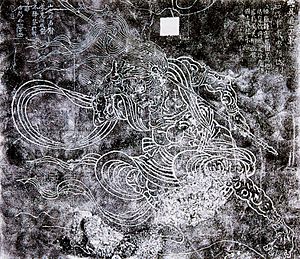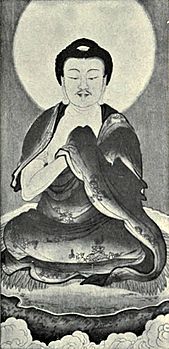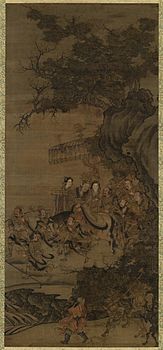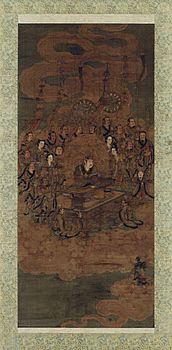Wu Daozi facts for kids
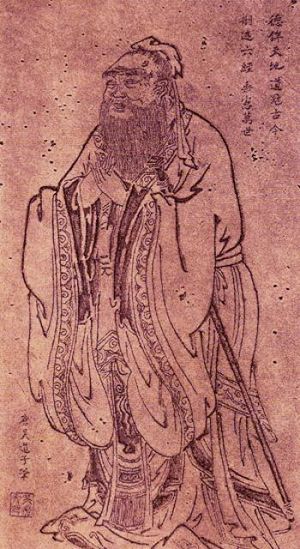
Quick facts for kids Wu Daozi |
|||||||||
|---|---|---|---|---|---|---|---|---|---|
| Traditional Chinese | 吳道子 | ||||||||
| Simplified Chinese | 吴道子 | ||||||||
|
|||||||||
| Daoxuan | |||||||||
| Chinese | 道玄 | ||||||||
|
|||||||||
Wu Daozi was a very famous Chinese painter. He lived during the Tang dynasty, a long time ago, from about 685 to 758 CE. People also knew him as Daoxuan or Wu Tao Tzu. An art expert named Michael Sullivan called him one of the "masters of the seventh century." Many of his paintings were large wall murals, but sadly, most of them are now lost. Some of his smaller works still exist today.
Wu Daozi grew up without his father and was quite poor. He first learned calligraphy, which is beautiful writing, from famous teachers. Later, he focused on painting. He was one of the first artists to use realistic techniques. He also helped set the rules for how to use brushes in painting. Wu Daozi was also a pioneer in landscape painting. When he painted people, he used round strokes to make their clothes look like they were flowing.
Contents
Amazing Artworks of Wu Daozi
Wu Daozi traveled a lot throughout China. He created many large wall paintings, called murals, in Buddhist and Daoist temples. He also painted beautiful pictures of mountains, rivers, flowers, and birds.
Sadly, none of his original paintings are still around today. However, we can see some of his work through copies made later. Some of his art was also carved into stone. For example, a famous painting of Confucius by Wu Daozi was saved because it was copied as a stone carving.
Fascinating Legends About Wu Daozi
Many legends are told about Wu Daozi. These stories often involve the powerful Emperor Xuanzong of Tang.
The Vanishing Painting
One famous story tells how Emperor Xuanzong asked Wu Daozi to paint a wall in his palace. Wu Daozi painted a stunning nature scene. It showed a rich valley with many plants and animals. At the bottom of a mountain, there was a cave. Wu Daozi told the emperor that a spirit lived in the cave. Then, he clapped his hands and walked into the painting, right into the cave! The entrance closed behind him. Before the amazed emperor could say a word, the entire painting vanished from the wall. This story shows how art can be very spiritual and magical.
Painting the Jialing River
Another legend says that Emperor Xuanzong sent Wu Daozi to Sichuan. He wanted Wu Daozi to study the green waters of the Jialing River. The emperor wanted a mural of the entire river. Supposedly, Wu Daozi came back without any sketches. He then quickly painted the whole river from memory in just one day! The painting showed 300 li (a Chinese unit of distance) of the river. Some stories add that another painter, Li Sixun, was with him. Li Sixun worked slowly, using many sketches. This legend probably just means Wu Daozi was very fast at painting. It doesn't mean he didn't use sketches at all.
The Secret Style
There is also a story about a painter who found one of Wu Daozi's last murals. This painter learned to copy Wu Daozi's unique style. Then, to make sure no one else could learn his secrets, he destroyed the wall. Some say he pushed it into a river.
Wu Daozi's Lasting Impact
Wu Daozi's art has continued to inspire people. For example, his painting called The Presentation of Buddha was shown on Chinese television in 2004 and 2005. His work truly left a big mark on Chinese art history.
-
Black and white reproduction of a portrait of Sakyamuni (the Buddha), attributed to Wu Daozi, published in 12th edition of Encyclopædia Britannica (1911)
See also
 In Spanish: Wu Daozi para niños
In Spanish: Wu Daozi para niños
- Chinese mythology
- Zhou Fang, another Tang dynasty painter


